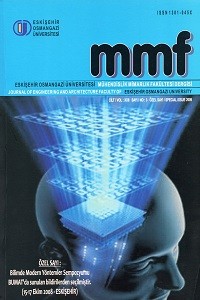Genleştirilmiş Kil Agregalı Hafif Betonlarda Bulanık Mantık Yöntemiyle Yarmada Çekme Dayanımı Tahmin Modeli Geliştirilmesi
Öz
Bu çalışmada, genleştirilmiş kil agregasıyla üretilen alternatif karışım özelliklerine sahip hafif betonlarda yarmada çekme dayanımı değerlerinin bulanık mantık yöntemiyle tahmin edilebilirliği araştırılmıştır. Bu amaçla 350, 400 ve 450 kg/m³ çimento dozajlarında genleştirilmiş kil agregalı hafif beton karışımları hazırlanmıştır. Her bir çimento miktarı için %0, %10, %20 ve %30 oranında uçucu kül ikame edilerek hazırlanan beton numuneleri yarmada çekme dayanımı deneyine tabi tutulmuştur. Modellemede girdi parametresi olarak çimento ve uçucu kül miktarları, çıktı parametresi olarak ise yarmada çekme dayanımı değerleri kullanılmıştır. Çalışmada girdi parametreleri için belirlenen üyelik fonksiyonlarına bağlı olarak 35 kural yazılmış durulaştırma işleminde ise en yaygın kullanılan yöntem olan ağırlık merkezi yöntemi kullanılmıştır. Sonuç olarak geliştirilen bulanık mantık modeli ile deneysel olarak elde edilmiş yarmada çekme dayanımı değerleri başarı ile belirlenmiştir.
Anahtar Kelimeler
Genleştirilmiş Kil Hafif Beton Bulanık Mantık Dolaylı Çekme Dayanımı.
Kaynakça
- [1] S. Yazıcıoğlu, N. Bozkurt, “Pomza ve Mineral Katkılı Taşıyıcı Hafif Betonun Mekanik Özelliklerinin Araştırılması”, Gazi Üniv. Müh. Mim. Fak. Der., Cilt. 21, No. 4, ss. 675- 680, 2006.
- [2] S. Subaşı, “The effects of using fly ash on high strength lightweight concrete produced with expanded clay aggregate”, Scientific Research and Essay, Vol. 4, No. 4, pp. 275-288, April, 2009.
- [3] S. Mindness, J. F. Young, “Concrete”, Prentice-Hall Inc., Englewood Cliffs, 1981.
- [4] İ. B. Topçu, “Beton Teknolojisi”, Uğur Ofset, Eskişehir 570s, 2006.
- [5] “Liapor”, http://www.liapor.com
- [6] Z. Şen, “Bulanık Mantık ve Modelleme İlkeleri”, Bilge Kültür Sanat, İstanbul, 2001.
- [7] İ. B. Topçu, Sarıdemir, M., “Prediction of properties of waste AAC aggregate concrete using artificial neural network”, Computational Materials Science, In Press, 2007.
- [8] İ. B. Topçu, M. Sarıdemir, “Prediction of mechanical properties of recycled aggregate concretes containing silica fume using artificial meural networks and fuzzy logic”, Computational Materials Science, In Press, 2007.
- [9] İ. B. Topçu, “Semi-Lightweight Concretes Produced by Volcanic Slags”, Cement and Concrete Research, Vol. 27, pp.15-21, 1997.
- [10] İ. B. Topçu, M. Sarıdemir, “Prediction of rubberized concrete properties using artificial neural network and fuzzy logic”, Construction and Building Materials, Vol. 22, pp.532- 540, 2008.
- [11] TS EN 12350-6, Beton – Sertleşmiş Beton Deneyleri, Bölüm 6: Deney Numunelerinin Yarmada Çekme Dayanımının Tayini, Türk Standartları Enstitüsü, Ankara, 2003.
- [12] L. A. Zadeh, “Fuzzy Sets”, Information and Control, Vol. 8., pp. 338-353, 1965.
- [13] S. Terzi, “Bitüm Miktarının Asfalt Betonu Dayanımına Etkisinin Bulanık Mantık Yöntemi İle Modellenmesi”, 4. Uluslar arası İleri Teknolojiler Sempozyumu, 28-30 Eylül, Konya, 2005.
- [14] Ö. Kişi, M. E. Karahan, Z. Şen, “Nehirlerdeki askı maddesi miktarının bulanık mantık ile modellenmesi”, İtüdergisi/d mühendislik, Cilt. 2, Sayı. 3, ss. 43-54, Haziran 2003.
Development Of A Split Tensile Strength Estimation Model On Lightweight Expanded Clay AggregateConcrete By Using Fuzzy Logic
Öz
In this study, split tensile strength values of the lightweight aggregate concrete, having alternative mix design, which is prepared with expanded clay aggregate have been modeled by fuzzy logic method. For this purpose, expanded clay aggregate concrete mix design has been prepared with 350, 400 and 450 kg/m3 cement content. Besides, 0%, 10%, 20% and 30% fly ash were substituted for each cement contents in the mix design. Prepared specimens were subjected for split tensile strength test. Input parameters were cement and fly ash content and the output parameters were split tensile strength in the modeling. Thirty five rules were formed according to the member functions which are determined for input parameters of the modeling. For the defuzzyfication process the centroid method was selected. Consequently, split tensile strength of the lightweight concrete was determined using the prepared fuzzy logic model in this study.
Anahtar Kelimeler
Expanded clay Lightweight concrete Fuzzy logic Split tensile strength.
Kaynakça
- [1] S. Yazıcıoğlu, N. Bozkurt, “Pomza ve Mineral Katkılı Taşıyıcı Hafif Betonun Mekanik Özelliklerinin Araştırılması”, Gazi Üniv. Müh. Mim. Fak. Der., Cilt. 21, No. 4, ss. 675- 680, 2006.
- [2] S. Subaşı, “The effects of using fly ash on high strength lightweight concrete produced with expanded clay aggregate”, Scientific Research and Essay, Vol. 4, No. 4, pp. 275-288, April, 2009.
- [3] S. Mindness, J. F. Young, “Concrete”, Prentice-Hall Inc., Englewood Cliffs, 1981.
- [4] İ. B. Topçu, “Beton Teknolojisi”, Uğur Ofset, Eskişehir 570s, 2006.
- [5] “Liapor”, http://www.liapor.com
- [6] Z. Şen, “Bulanık Mantık ve Modelleme İlkeleri”, Bilge Kültür Sanat, İstanbul, 2001.
- [7] İ. B. Topçu, Sarıdemir, M., “Prediction of properties of waste AAC aggregate concrete using artificial neural network”, Computational Materials Science, In Press, 2007.
- [8] İ. B. Topçu, M. Sarıdemir, “Prediction of mechanical properties of recycled aggregate concretes containing silica fume using artificial meural networks and fuzzy logic”, Computational Materials Science, In Press, 2007.
- [9] İ. B. Topçu, “Semi-Lightweight Concretes Produced by Volcanic Slags”, Cement and Concrete Research, Vol. 27, pp.15-21, 1997.
- [10] İ. B. Topçu, M. Sarıdemir, “Prediction of rubberized concrete properties using artificial neural network and fuzzy logic”, Construction and Building Materials, Vol. 22, pp.532- 540, 2008.
- [11] TS EN 12350-6, Beton – Sertleşmiş Beton Deneyleri, Bölüm 6: Deney Numunelerinin Yarmada Çekme Dayanımının Tayini, Türk Standartları Enstitüsü, Ankara, 2003.
- [12] L. A. Zadeh, “Fuzzy Sets”, Information and Control, Vol. 8., pp. 338-353, 1965.
- [13] S. Terzi, “Bitüm Miktarının Asfalt Betonu Dayanımına Etkisinin Bulanık Mantık Yöntemi İle Modellenmesi”, 4. Uluslar arası İleri Teknolojiler Sempozyumu, 28-30 Eylül, Konya, 2005.
- [14] Ö. Kişi, M. E. Karahan, Z. Şen, “Nehirlerdeki askı maddesi miktarının bulanık mantık ile modellenmesi”, İtüdergisi/d mühendislik, Cilt. 2, Sayı. 3, ss. 43-54, Haziran 2003.
Ayrıntılar
| Konular | İnşaat Mühendisliği |
|---|---|
| Bölüm | Araştırma Makaleleri |
| Yazarlar | |
| Yayımlanma Tarihi | 31 Aralık 2009 |
| Kabul Tarihi | 8 Haziran 2009 |
| Yayımlandığı Sayı | Yıl 2009 Cilt: 22 Sayı: 3 |

